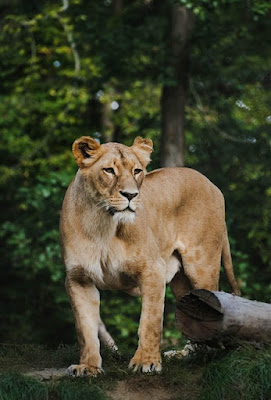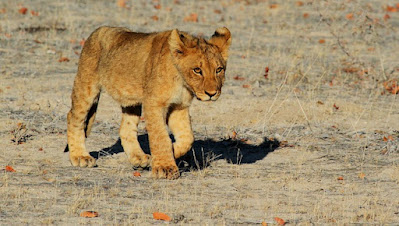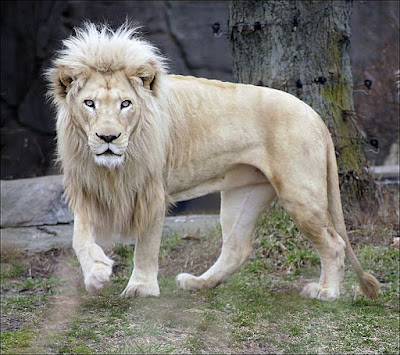Majestic Roar: Discovering the World of Lions
Over the vast savannahs and grasslands of Africa, one apex predator reigns with unparalleled grace and power. The lion, often referred to as the "king of the jungle", is a symbol of strength, courage and majesty. With its iconic mane and impressive presence, the lion has captured the imagination of humans for centuries. In this article, we delve into the captivating world of lions, exploring their behavior, habitat, social structure and conservation status.
Habitat and Distribution:
Lions primarily inhabit sub-Saharan Africa, where their presence can be found in a range of ecosystems, including grasslands, savannas, and open woodlands. They are notably absent from dense forests and deserts. Historically, lions have also occupied parts of Europe, the Middle East, and Asia, but their populations have declined significantly in these areas.
Physical Characteristics:
One of the most recognizable features of a lion is the male's majestic mane, which surrounds its head and neck. This distinctive feature is absent in lionesses. The mane serves several purposes, including providing protection for the neck during fighting and serving as a visual indicator of the male lion's health and dominance.
Lions are large carnivores, with adult males weighing between 330 to 550 pounds (150 to 250 kg) and about 4.5 to 6.5 feet (1.4 to 2 m) in length, excluding the tail. Lionesses are generally smaller, weighing around 265 to 400 pounds (120 to 180 kg). Both males and females have powerful bodies, sharp claws and strong jaws equipped with sharp teeth for hunting and eating prey.
Social structure:
Lions are known for their social behavior, often forming groups called prides. A typical pride consists of related lionesses, their cubs and a dominant male or a coalition of males. Lionesses are mainly responsible for hunting, while the male's role includes defending the territory and pride from rival males.
Male lions often establish their dominance through fierce battles, as only the strongest and most formidable individuals get the right to lead the pride. Male coalitions, consisting of two to four individuals, are also known to work together to maintain their position and defend their territory.
Hunting and Diet:
Lions are apex predators, meaning they sit at the top of the food chain. They mainly feed on a variety of ungulates including zebra, wildebeest, buffalo and various antelope species. Lionesses are the main hunters, using their cooperative nature to increase their success rates during the hunt. Their ability to work together to stalk and ambush prey makes them skilled hunters.
Conservation status:
While lions are culturally important and revered, their population has faced a number of challenges that have led to a decline in their numbers. Habitat loss due to human activities, conflict with local communities, and poaching are among the primary threats to their existence. The International Union for Conservation of Nature (IUCN) lists lions as "Vulnerable" on its Red List of Threatened Species.
Conservation efforts are being made to protect lion populations, with a focus on preserving their habitats, reducing human-wildlife conflict, and combating poaching and trade. The initiative also aims to raise awareness about the importance of lions in maintaining the balance of the ecosystem and their cultural significance.
The majestic appearance and distinctive features of the lion have earned it a special place in our hearts and culture. As a symbol of strength and courage, the lion continues to captivate the world with its majestic image and impressive roar that reverberates across African landscapes. It is our responsibility to ensure the survival of this iconic species for generations to come, allowing future generations to marvel at the grandeur of the true King of the Savannah.
Here are some interesting facts about lions:
- Social animals: Lions are the only truly social cats, living in groups called prides. A pride can consist of 5 to 30 lions, including lionesses, cubs and a few dominant males.
- Majestic Mane: Male lions have manes, which are unique to each individual and can range from blond to black. The mane is a symbol of maturity and health of the lion, and it also plays a role in attracting females.
- Hunting Strategy: Lionesses are the primary hunters in the pride. They work together in coordinated efforts to stalk and ambush prey. Their success rate increases when hunting in a group.
- Territory and Roar: Lions are territorial animals. A roar can be heard up to 5 miles (8 km) away and serves to establish their presence and warn off intruders.
- Sleeping Habits: Lions are often associated with laziness because they spend about 16 to 20 hours a day resting. However, this behavior is due to their efficient energy conservation strategy, as they save energy for hunting and social interaction.
- Size and Strength: Lions are among the largest cat species. Adult males can weigh between 330 to 550 pounds (150 to 250 kg), and females typically weigh between 265 to 400 pounds (120 to 180 kg).
- Powerful hunters: Lions have powerful front legs and shoulders, which help them take down large prey. Their sharp retractable claws and strong jaws help them to catch and dismember their prey.
- Cubs and Care: Lionesses give birth to large litters of cubs, usually 1 to 4 cubs. Cubs are born blind and weak and are dependent on their mother's care and protection. They start hunting with the pride at about 11 months of age.
- Threats and Conservation: Lions are listed as "Vulnerable" on the IUCN Red List due to habitat loss, conflict with humans, and poaching. Conservation efforts are being made to protect their habitats, manage human-wildlife conflict, and combat poaching.
- Cultural Significance: Lions have been featured in various cultures and religions throughout history. They are a symbol of strength, bravery and royalty, often depicted as guardians and rulers in mythologies around the world.
- Historical range: While lions are now mainly found in sub-Saharan Africa, historically, they were more widespread, including parts of Europe, the Middle East, and Asia. However, their population has declined significantly in these areas.
- Communication: Lions communicate through vocalizations, body language, and scent marking. Roars, growls, grunts, and other sounds help them communicate messages within the pride and to neighboring lions.
- Role of the Male: Male lions play an important role in defending the pride's territory and protecting the cubs. They are often seen patrolling and marking their territory with scent marks.
- Hybridization: In some areas, lions have been known to hybridize with tigers, resulting in hybrids known as ligers or tigons. However, these hybridizations are extremely rare in the wild.





Comments
Post a Comment